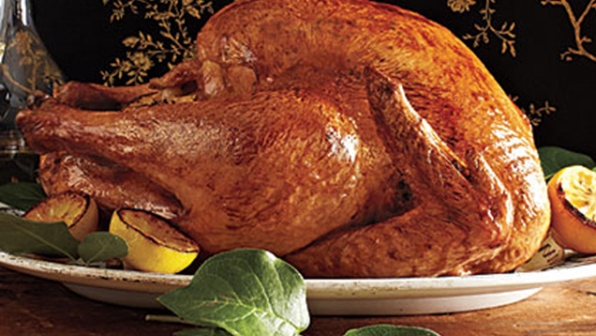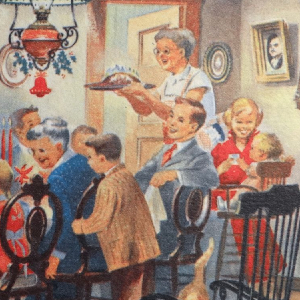It’s a little more than 24 hours until the big event. No, not the tree and the presents. Not the family photos of everyone with their gifts. Not the arrival of your dinner guests. I’m talking about dinner itself. And there is lots you can do now, before the pressure is on, to make tomorrow less hectic!
 The perfect Christmas Turkey: I can show you how to achieve it!
The perfect Christmas Turkey: I can show you how to achieve it!
This year, for my Christmas Eve post, I’m going to run down some of my all-time favourite tips, and my responses to the most-asked questions I’ve had over the years about the big event and the dishes that make it so special.
Make-ahead minimizes the madness
I’m assuming you have all the stuff you need for Christmas Dinner in the house – aside, of course, for ingredients you may have forgotten, or decide you want to add to the picture. Now’s the time to go down your master list and make sure you’ve got what you need. If there’s something you do need, you’ll have until 5 or 6 p.m this afternoon to run out and get it. After that, you’re out of luck!
Mashed Potato perfection
I’m often asked how I get my mashed potatoes to turn out so smooth and creamy and flavourful. It’s nothing special, but you do need to watch your proportions with the extra ingredients I add. I use Russet Potatoes, boil them in the conventional way (starting them off in cold water with a good pinch of salt), drain them, and let them steam completely dry. Then I add a knob (level tablespoon) of butter and 1/4 cup cream or whole milk per spud, and go at the pot with the masher again until the whole mass is consistently smooth and creamy.
Don’t use too much butter or milk, or you’ll end up with something the French call Pommes de Terres Purées – pretty loose. The French love it that way, but most Brits and North Americans don’t!
No-fail Scalloped Potatoes
I’ve had everyone ask me this at one time or another, from the operator at the next chair at the hair dresser, to a novice cook, tackling her first family feast. In almost all cases, the frustrated hosts and hostesses were trying to make the classic dish, where you add milk and/or cream to the casserole of sliced potatoes. Some added a couple of eggs, others didn’t. It all depended on whose treasured family recipe they were following.
My recommendation is to set the family secrets aside and try my way. Just once. I make a big pot of medium-thick Béchamel (cream) sauce and add a generous amount of white cheddar cheese to transform it into a Mornay. First, I pour enough sauce into the casserole dish to cover the bottom at least 1/4 in. / 1 cm deep. After stacking the potato slices and slivered onions in alternate layers, I pour on the rest of the Sauce and let it run down between the spuds and onions. I top the dish in one of two ways: either a generous coating of buttered bread crumbs (a classic presentation), or a few handfuls of grated White Cheddar. Either option comes out beautiful and golden brown, and bubbly!
You can make this dish the day before and just re-heat it on the big day. Or you can put it together the day before and store it tightly covered in the fridge until its time to put it in the oven on Christmas afternoon. I always prefer it freshly baked (option 2) on the day it’s intended to make its début!
I’ve shared this open secret to perfect Scalloped Potatoes with lots of folks over the years (including my late, great ‘Master Chef’ step dad), and not one of them failed to create ‘the best Scalloped Potatoes they’ve ever served’!
Broccoli blues washed away
Somehow, Broccoli always seems to find its way onto most folks’ Christmas feast tables. But a lot of folks have never learned to cook it properly. I’ve heard a lot of complaints (even from my own mother!) that my broccoli was too hard; under-cooked. Other folks have said they have trouble pulling their broccoli off the heat before it turns to mush. There is a very fine line, not to be crossed!
My secret for perfectly al dente broccoli is to steam it, not boil it. Sounds simple, but steaming is vital to preserving the structure of the florets while ensuring they (and their stems) are cooked through. You’ll also find you have better control over the salt and pepper when you steam. The seasoning doesn’t get lost in the water! And you can pull the steaming basket off the heat any time you feel is right.
Brussels sprouts the way everyone will like them
Brussels sprouts are a bone of contention, even among members of close families. You either love them or hate them. I love them, and I’ll eat them any way they’re prepared. Provided they’re cooked through and full of flavour.
There’s no excuse for hard, grassy-tasting sprouts. he grassy, cabbagy taste disappears if they’re coked trough properly, and I have a couple of ways to infuse your sprouts with rich, buttery, roasted flavour everyone will love.
One way is literally to roast them. Cut them in half lengthwise and spread them on a baking sheet lined with parchment paper or kitchen foil. Give them a generous drizzle of melted butter and a sprinkle of salt and pepper. Then dust them with a dose of freshly ground Nutmeg. That’s right, Nutmeg. Or, if you prefer, ground caraway or cumin. You’ll be amazed what any of these three spices will do for plain old Brussels sprouts! They’ll take about an hour at 375 F (at which most folks roast their Turkey). They should come out tender but not mushy, and golden wherever the butter touched them.
The other method I use is to steam the halved sprouts until par-cooked, then dress them with butter, seasoning and an appropriate spice (see above). Then, I pan fry them gently rolling them so all sides brown. But let ‘gently’ be your guiding rule: too much agitation or stirring will make them fall apart…
Now, see who doesn’t like Brussels sprouts!
Never run short of stuffing again!
It happens every year at our house. No matter if there are 3 people sitting down to the table or 13, we always run out of stuffing before everyone has had their fill. At least, we used to. For some time now, I’ve been stuffing the bird and preparing a casserole of the same stuffing mixture to bake on the side. You’ll have to pour enough chicken or turkey stock over the filled casserole to ensure the interior stays moist (but not soggy!), and liberally dab the top surface of the stuffing with butter. This will help ensure that the top is crispy and golden. And the melted butter running down through the stuffing mass will make up for the fat that would otherwise be lost from not cooking inside the bird. Bake for 45 min covered, and another 15 min or so uncovered to crisp up the top.
Turkey tips for the perfect bird
I’ve committed a post in the past to Turkey Tips that will make your festive bird exceptional. I’ve also posted a focus piece on how to achieve that beloved crispy, golden skin on your bird. I’ve even gone into the dos and donts of making perfect gravy. Refer to these as needed – if needed!
Pumpkin pie perfection
I long ago posted a detailed treatise in this space on the Perfect Pumpkin Pie. But the key points bear repeating. Remember, you’re essentially making a custard: you’ll need all the milk and cream the recipe calls for, and both the eggs to ensure that it sets properly. I don’t know what your personal pumpkin pie spice blend calls for, but mine always includes nutmeg and just 1/2 tsp. / 2.5 ml of ground cloves. The flavour just isn’t the same without them, and the cloves alone will raise your pie above the masses. Also, make sure to pre-heat the oven to 420 F or 425 F and leave it there for the first 15 – 20 minutes of baking. After that, turn the oven down to 375 F, as usual. This will quickly consolidate the crust so that it doesn’t get soaked through by the filling before the custard sets. Use this tip to ensure that the crusts on all your custard pies, fruit pies and quiches come out perfect!
Have a great Christmas dinner
Make it one everyone around the table will remember – for the right reasons!
~ Maggie J.

